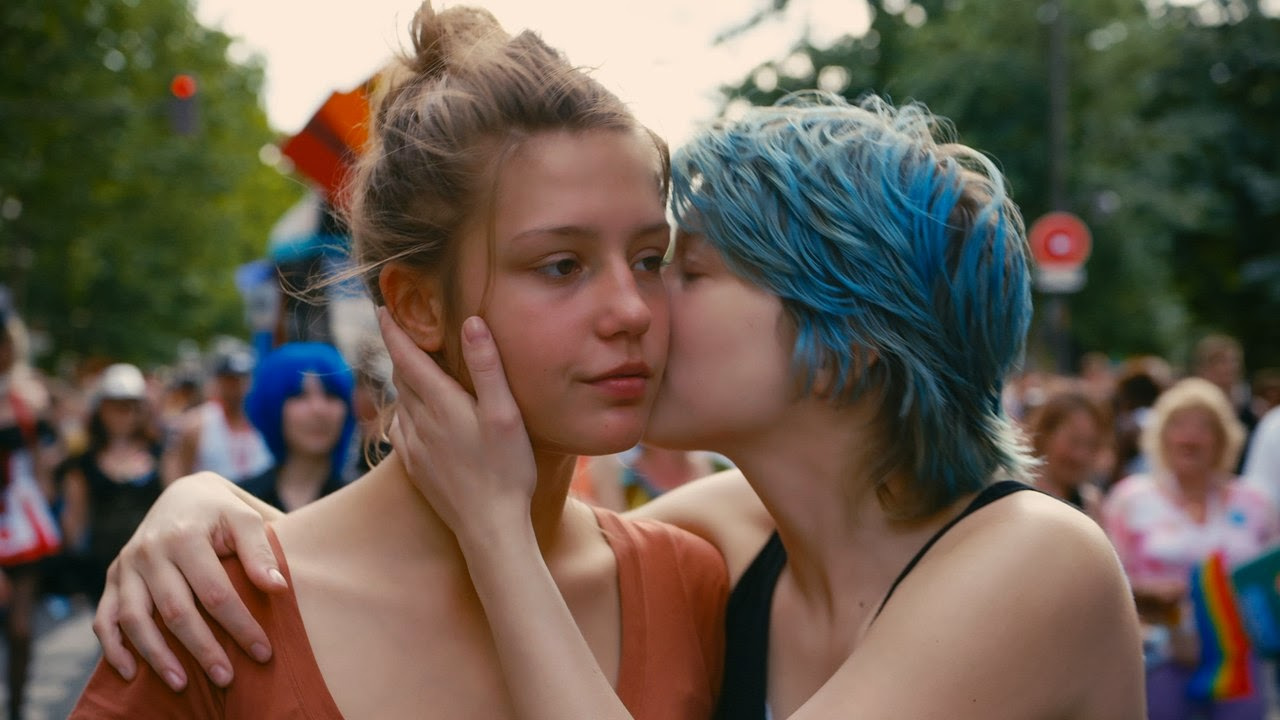Back in the summer, eyebrows were raised by many film fans when Abdellatif Kechiche’s controversial French drama Blue is the Warmest Colour debuted at the Cannes Film Festival (winning the coveted Palme d’Or award in the process). But despite criticism about the explicit lesbian sex scenes between leading actresses Adèle Exarchopolous and Lèa Seydoux, the film has become widely acclaimed and is looking a surefire favourite to win 2014’s Best Foreign Language Oscar. A word of advise to male viewers though, do not take your family or your missus to watch it! You have been warned….
SYNOPSIS: Student Adèle (Exarchopolous) struggles to open up about her sexuality even when she has a fling with handsome classmate Thomas. But when she meets blue-haired lesbian Emma, her life changes completely. The pair develop a strong understanding for each other which eventually leads to a risky yet passionate relationship. However during their time together, Adèle begins to feel disillusioned about how different she is to her partner and once again starts to doubt her sexuality which threaten to destroy their relationship.
Abdellatif Kechiche’s complex story of love, passion and sexual identity is carried out with great precision by the flamboyant filmmaker. Adapted from the graphic novel of Julie Maroh, the film carefully tracks the point-of-view of its leading character Adèle as she endures mixed emotions over the course of the epic three-hour running time. Throughout the story, she experiences a journey of mixed feelings which come from the pure thrill of romance. In the beginning, she struggles to think about her future aspirations especially when it comes to dealing with her own sexuality. When she gets together with Thomas, it is mostly a desperate attempt to prove to her friends that she is capable of making love with a man even when she feels embarrassed to admit it. But once Thomas is abruptly forced out of the picture, Adèle turns her attention to this mysterious blue-haired woman who will ultimately change her life. Although, it takes around 45 minutes for the pair to finally converse, this is where the film starts to really shine as the pair chat about what they want most from life. Their time together then triggers the first of three heavily-discussed sex scenes (the first of those goes on for a lengthy seven minutes) that have got many people talking. While some viewers are bound to be uncomfortable at the sight of these two young women indulging in raw and explicit sex, Kechiche produces a masterstroke of appointing cinematographer Sofian El Fani to capture these intimate moments of love. Though the scenes are bound to be dismissed as nothing more than cinematic pornography, the depth of sexual passion displayed in them is what makes the romance feel authentic and real. Aside from that, the film does remarkably well in illustrating the tender love between the two characters even to the point where their worlds are completely different. The key aspect of this comes from the scenes of the pair visiting each others homes. While Adèle is happy to eat spaghetti (a working class meal) with her own family, she is taken aback by the arty meal that Emma’s parents give her in the form of oysters. The contrasts of the two sets of parents is also explored with Emma’s mum and dad looking visibly disappointed in Adele’s lack of drive compared to the dismay of Adèle’s parents when they learn about Emma’s artistic ambitions. This eventually kicks off the insecurity that Adèle feels about their goals over the next couple of years as they embark on different career paths that will eventually cause problems as the film progresses. The relationship finally hits its rocky patch in the final quarter as Adele’s sense of dread and lack of power leads to the eventual downfall of their romance. The two scenes which convey this are completely different in terms of emotion but they still make us care for the fate of these two girls and pays off devastatingly in the film’s bittersweet climax. What requires the film to be strengthened most is the astonishing performances of its two leading ladies. Sharing the same name as her character, newcomer Adèle Exarchopoulos carries the film with great natural ability and bares her soul (more then once!) to mesmerising perfection as the camera remains fixated on her throughout. Given her youthful age and beautiful stature, a promising future is surely guaranteed. Co-star Lea Seydoux is just as majestic as the woman who changes Adèle’ life and while she doesn’t feature as much, her contribution is still significant in the endearing scenes between the two characters with her best moments coming in the film’s emotional last quarter.
What does take away the film’s momentum is the way Kechiche drags the story out which explains the padded 180 minute running time. Several scenes take a long time to get through which is something that audiences may have a hard time to deal with (as well as the lengthy sex scenes). The chronological side of the story also proves distracting as it skips through time very quickly particularly in Adèle’s case as her leap from teenage student to 20ish year old teacher plods along without much development. The same can also be said for the supporting characters who come and go and are barely seen in the second half of the film e.g. Adèle’s parents (whose reaction to the relationship is never shown) and her friends.
VERDICT: Despite its lengthy running-time and chronological issues, Blue is the Warmest Color powerfully depicts love in a beautiful way whilst also benefiting from the flawless performances of its beautiful leading stars Exarchopolous and Seydoux.


Be the first to comment on "Blue is the Warmest Colour – ★★★★"